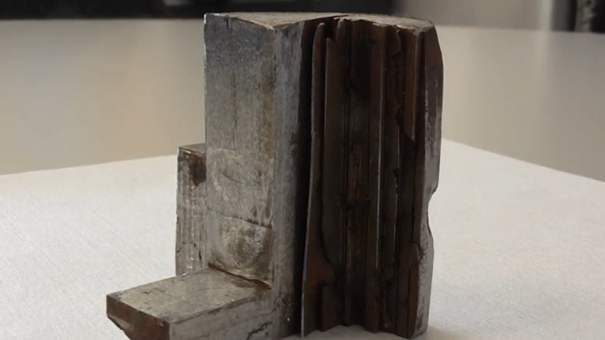
LAUSANNE, SWITZERLAND (Reuters) — Prehistoric meteorite fragments found in Namibia could be the ideal natural catalyst to store energy from renewable sources, according to a team of Swiss scientists.
Pieces of the Gibeon meteorite are found over 20,000 square kilometres (7722 square miles) in the southern African nation and have a total mass of more than 21 tonnes.
Scientists at the Swiss Federal Institute of Technology in Lausanne (EPFL) found that it is the composition of the meteorite which is key to its effectiveness as a catalyst.
The catalyst is used to split water into oxygen and hydrogen gas – a process called water oxidation. An electric current is passed through electrodes, generating hydrogen fuel, which can be used to store energy from renewable sources like the sun or wind.
The study, led by Kevin Sivula and published in the Energy & Environmental Science journal, found that the impurities of nickel and cobalt found in the Gibeon meteorite fragments made it a particularly efficient catalyst.
“We’ve discovered something quite interesting, which was an atomic re-arrangement that occurred at the surface of the Gibeon meteorite, actually concentrating the electro-active nickel atoms at the surface, making likely a special type of layered oxyhydroxide or iron, nickel, and cobalt at a specific composition which was dictated by the initial composition of the meteorite that led to a very high activity for this oxygen evolution reaction,” Sivula told Reuters.
The team tested the catalytic properties of the meteorite fragment by building them into electrodes.
“In this study we’ve used a meteorite, this piece, we cut it in slices. After taking the different slices we remove the oxide that has formed during the cutting process, then stuck it on a glass piece for mechanical stability – and of course we also solder an electric wire and covered it with a non-reactive glue in order to define a real area for the chemical experiments with that,” explained researcher Florian le Formal.
The team found that the meteorite electrodes outperformed man-made materials.
“In this experiment we apply an electric potential between the piece of meteorite we prepared before and a piece of metal – here platinum – so with this electric potential we can split water forming oxygen on the meteorite and hydrogen on the controlled electron. In this way we can form a fuel from a renewable source of energy. And what we observe is during this chemical process the meteorite was improving its performance by forming a very active layer on its surface,” Formal added.
The team says the properties of the meteorite fragments point to what could be used on a large scale in cheap and efficient electrolyser devices.
Sivula says the Gibeon meteorite could hold the key to making renewable energy a cheaper and more efficient option than fossil fuels.
“In an eventual future without fossil fuels we’ll need some way to store renewable energy. So when it’s very windy outside we can produce a lot of wind electricity via wind energy, but if we don’t use that electricity right away then we lose it. So we need some way to store excess renewable electricity in some way. We could use potentially a standard battery like the battery that exists in your phone, but the length of time you can store energy in a battery is limited,” he said
The Swiss researchers say their study of the extraterrestial electrodes demonstrates the potential for natural materials to be used as high performing electrocatalysts in the future.







